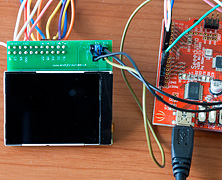It’s been a few months now since I released the original two articles that detailed the design, build and optimised software library for the 2.0″ Nokia 6300 QVGA TFT connected to the Arduino Mega XMEM interface. Judging by the responses I’ve had, there’s a lot of you...
Interfacing the Nokia 6300 QVGA TFT to the standard Arduino
posted by Andy
In two of my previous articles (here and here) I explained how we could connect the 8-bit 8080 interface presented by the TFT panel to the XMEM interface of the Arduino Mega to achieve a high performance full-colour graphical interface. I went on to present a high-performance open-source...
Nokia QVGA TFT LCD for the Arduino Mega. Design and build (part 1 of 2)
posted by Andy
In two of my previous articles I showed you how to reverse engineer the Nokia 2730 LCD for connecting to a device with 3.3V I/O’s and then I showed you how to build a 16-channel level converter for connecting devices together that have differing I/O level requirements. This article...
Nokia QVGA TFT LCD for the Arduino Mega. Graphics Library (part 2 of 2)
posted by Andy
In part 1 of this two part series I presented the hardware design and build for the Nokia 6300 TFT that shows how we can connect it directly to the external memory interface of the Arduino Mega and that by doing so we achieve the fastest possible interface between the TFT and the Arduino...




